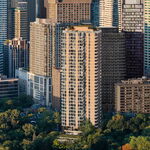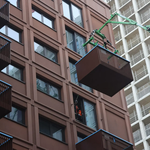Bordercollie
Senior Member
There is no freight service west of Stratford? Why did CN take back the line then?Interesting that there was a business case for High Speed Rail, but slightly improving the line is off the table......
Hmm...
There is no freight service west of Stratford? Why did CN take back the line then?Interesting that there was a business case for High Speed Rail, but slightly improving the line is off the table......
Hmm...
There is no freight service west of Stratford? Why did CN take back the line then?
Cost benefit analysis comes in again. It can cost more to spend less.Interesting that there was a business case for High Speed Rail, but slightly improving the line is off the table......
Hmm...
Interesting that there was a business case for High Speed Rail, but slightly improving the line is off the table......
Hmm...

Assuming you are talking about the Collenette HSR in Ontario plan, the preferred route would bypass Stratford and St. Marys, so it was not the same line but a new one.

Has the HSR line gone out for tender?It absolutely was a new line.
My point isn't the line or what line, my point is that it is odd that is a business case and ridership for a $15 billion dollar HSR line stopping at Guelph, Kitchener and London, but not for upgrades to the GEXR line at a fraction of the cost. Hmmm...
First of all, the "business case" for the Ontario Liberal's Toronto-London HSR proposal was based on a BCR of 1.02 (i.e. about the smallest-possible margin above "destroying more value than it creates"):It absolutely was a new line.
My point isn't the line or what line, my point is that it is odd that [there] is a business case and ridership for a $15 billion dollar HSR line stopping at Guelph, Kitchener and London, but not for upgrades to the GEXR line at a fraction of the cost. Hmmm...
As for the published Special Advisor's Final Report, once you note that the BCR decreases as the design speed increases and as the length (and especially the distance from Toronto) increases, you might guess what additional column and line I would have expected to see in the table below:

Source: High Speed Rail in Ontario - Special Advisor for High Speed Rail: Final Report (p. 46)
As I've pointed out repeatedly in the the High Speed Rail: London - Kitchener-Waterloo - Pearson Airport - Toronto thread, the northern route is much easier to adapt to fast and frequent intercity services and serves much more population, even if it might be marginally slower than the Southern route:That southern route is better in its current state, perhaps...but as with HFR to the east, the question is how much use CN will allow. The Stratford route has much more upside potential for adding more trains without conflicting with freight. As to travel time, the line west of Kitchener is largely straight with only a couple of places where it would have to remain slow. It could easily be upgraded to 100 mph. Some bridge work might be needed. At that quality, the time difference would be eliminated. Right now, speed west of Stratford is in the 60-65 km/h range, which is downright pathetic. One has to think that a single-seat ride between Guelph/Kitchener and Chatham/Windsor would have appeal.
Which reminds me - I haven't heard that CN and VIA/GO have a final agreement to increase service between Halwest and Silver - if that segment isn't available, the entire discussion is moot.
- Paul
I refer to one of my first posts here in this forum, in which I compared the Toronto-Brantford-London, Toronto-Brantford Cut-off- London and Toronto-Kitchener-London routes with each other, including the following graphs/tables:



The fact that this project surfaced out of nowhere just in time for the 2014 election and nothing was heard until just a few months before the 2018 election (in the form of the HSR study I just quoted) certainly speaks in that direction...^It’s possible that the Wynne government actually believed that HSR was a valid transportation solution for Southern Ontario and that they were positioned to deliver it. I’m inclined to think their interest was a lot more superficial. They shamelessly promised an awful lot without having the slightest idea how to get there, and they were very skilled at backing away from test balloons that turned out to be unsustainable.
Building a new line when the Stratford line is so underutilised made no practical sense. Maybe in 2040.....
- Paul
But I thought that an actual bi-pass was designed and negotiated around Bramelea GO station but the Doug ford government was able to get it done for cheaper? I'm not sure what the difference is in design.As I've pointed out repeatedly in the the High Speed Rail: London - Kitchener-Waterloo - Pearson Airport - Toronto thread, the northern route is much easier to adapt to fast and frequent intercity services and serves much more population, even if it might be marginally slower than the Southern route:
The fastest and most direct route would of course be the "Toronto-Harrisburg-Thamesford-London" alignment I outlined back then, but the map I made back in my early days here in UT also shows quite clearly how effective it is in avoiding any population centers (other than Woodstock) between Toronto's greenbelt and London:

Re-post from the High Speed Rail: London - Kitchener-Waterloo - Pearson Airport - Toronto thread
That said, you are of course right that any alignment along the Northern route will realistically depend on the construction of the "Missing Link", but that link would allow the increase "desirable" rail traffic (i.e. passenger services) going through (and stopping in) Brampton, while diverting "undesirable" rail traffic (i.e. non-local freight traffic) around it, while the "Brantford Bypass" would fail to achieve either (by reducing/eliminating passenger traffic, while keeping freight traffic unchanged)...
The fact that this project surfaced out of nowhere just in time for the 2014 election and nothing was heard until just a few months before the 2018 election (in the form of the HSR study I just quoted) certainly speaks in that direction...
That said, you are of course right that any alignment along the Northern route will realistically depend on the construction of the "Missing Link", but that link would allow the increase "desirable" rail traffic (i.e. passenger services) going through (and stopping in) Brampton, while diverting "undesirable" rail traffic (i.e. non-local freight traffic) around it, while the "Brantford Bypass" would fail to achieve either (by reducing/eliminating passenger traffic, while keeping freight traffic unchanged)...
You may find some tables and graphs I posted back in fall interesting:




